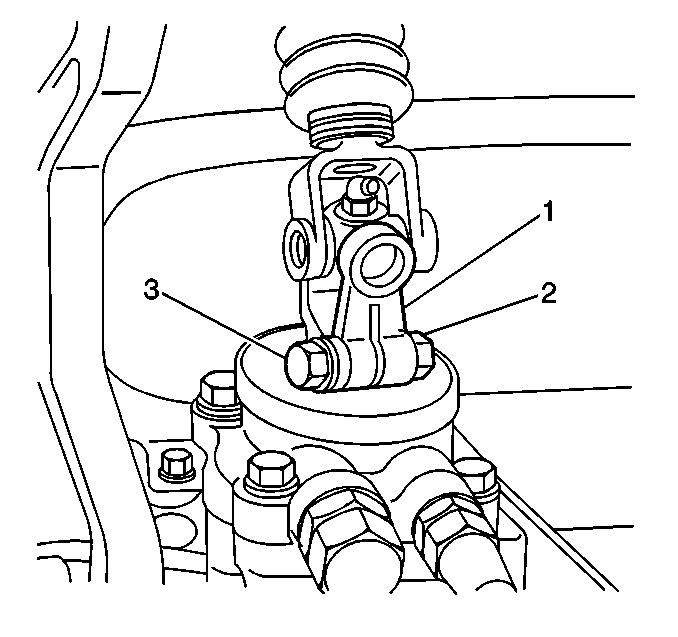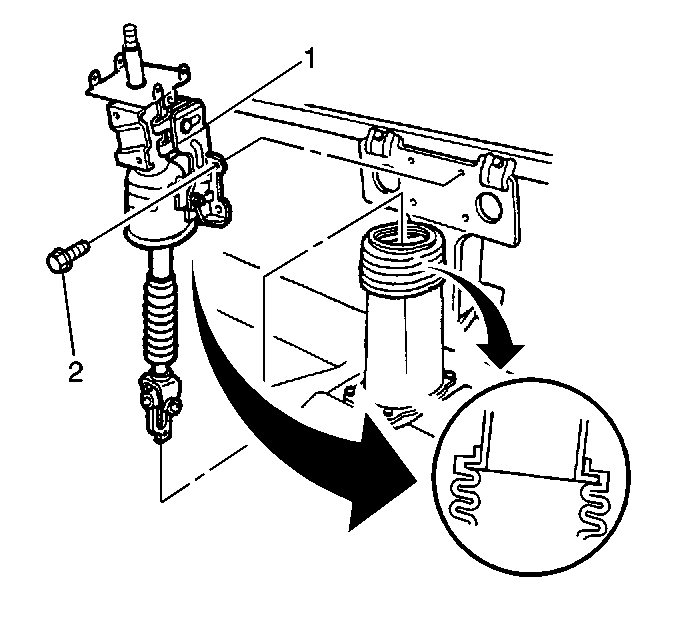Removal Procedure
- Disconnect the negative battery cable.
- Remove the steering wheel. Refer to Steering Wheel Replacement .
- Remove the column filler panel screws and panel.
- Disconnect the trailer brake linkage or the shift cable from the column control lever, if the vehicle is equipped.
- Remove the upper joint bolt (2) from the steering shaft. Mark the relationship of the upper joint to the steering shaft.
- Remove the bolts (2) and the nut from the toe plate.
- Remove the plastic tie strap holding the electrical harness to the column.
- Disconnect the electrical connectors from the steering column harness.
- Remove the nuts holding the column support bracket to the instrument panel.
- Remove the steering column assembly (1). Rotate the column in order for the trailer brake control lever to clear the dash opening.

Caution: Unless directed otherwise, the ignition and start switch must be in the OFF or LOCK position, and all electrical loads must be OFF before servicing any electrical component. Disconnect the negative battery cable to prevent an electrical spark should a tool or equipment come in contact with an exposed electrical terminal. Failure to follow these precautions may result in personal injury and/or damage to the vehicle or its components.

For models equipped with a column shift follow the additional steps for the lower steering column:
| 8.1. | Disconnect the electrical switch. |
| 8.2. | Remove the electrical switch and cover. |
Installation Procedure
- Install the lower end of the steering column through the dash opening.
- Install the support bracket nuts, loosely.
- Guide the steering shaft into the upper joint.
- Install the upper joint bolt. The bolt must pass through the shaft undercut.
- Install the bolts through the plate and the seal to the dash panel.
- Install the wiring connectors to the steering column harness.
- Install a new tie strap to secure the wiring harness to the steering column.
- Install the steering column filler panel.
- Install the steering wheel. Refer to Steering Wheel Replacement .
- Connect the trailer brake linkage or the shift cable to the column control lever, if the vehicle is equipped.
- Connect the negative battery cable.

Caution: In order to ensure the intended function of the steering
column in a vehicle during a crash and in order to avoid personal injury to
the driver, perform the following:
• Tighten the steering column lower fasteners before you tighten
the steering column upper fasteners. Failure to do this can damage the steering
column. • Tighten the steering column fasteners to the specified torque.
Overtightening the upper steering column fasteners could affect the steering
column collapse.
Finger tighten the nuts.
Align the marks which were made at the removal.
Notice: Use the correct fastener in the correct location. Replacement fasteners must be the correct part number for that application. Fasteners requiring replacement or fasteners requiring the use of thread locking compound or sealant are identified in the service procedure. Do not use paints, lubricants, or corrosion inhibitors on fasteners or fastener joint surfaces unless specified. These coatings affect fastener torque and joint clamping force and may damage the fastener. Use the correct tightening sequence and specifications when installing fasteners in order to avoid damage to parts and systems.
Tighten
Tighten the upper joint nut to 62 N·m (45 lb ft).
Tighten
| • | Tighten the lower steering column support bracket bolts/nut to 13 N·m (115 lb in). |
| • | Tighten the upper steering column support bracket nuts to 27 N·m (20 lb ft). |
